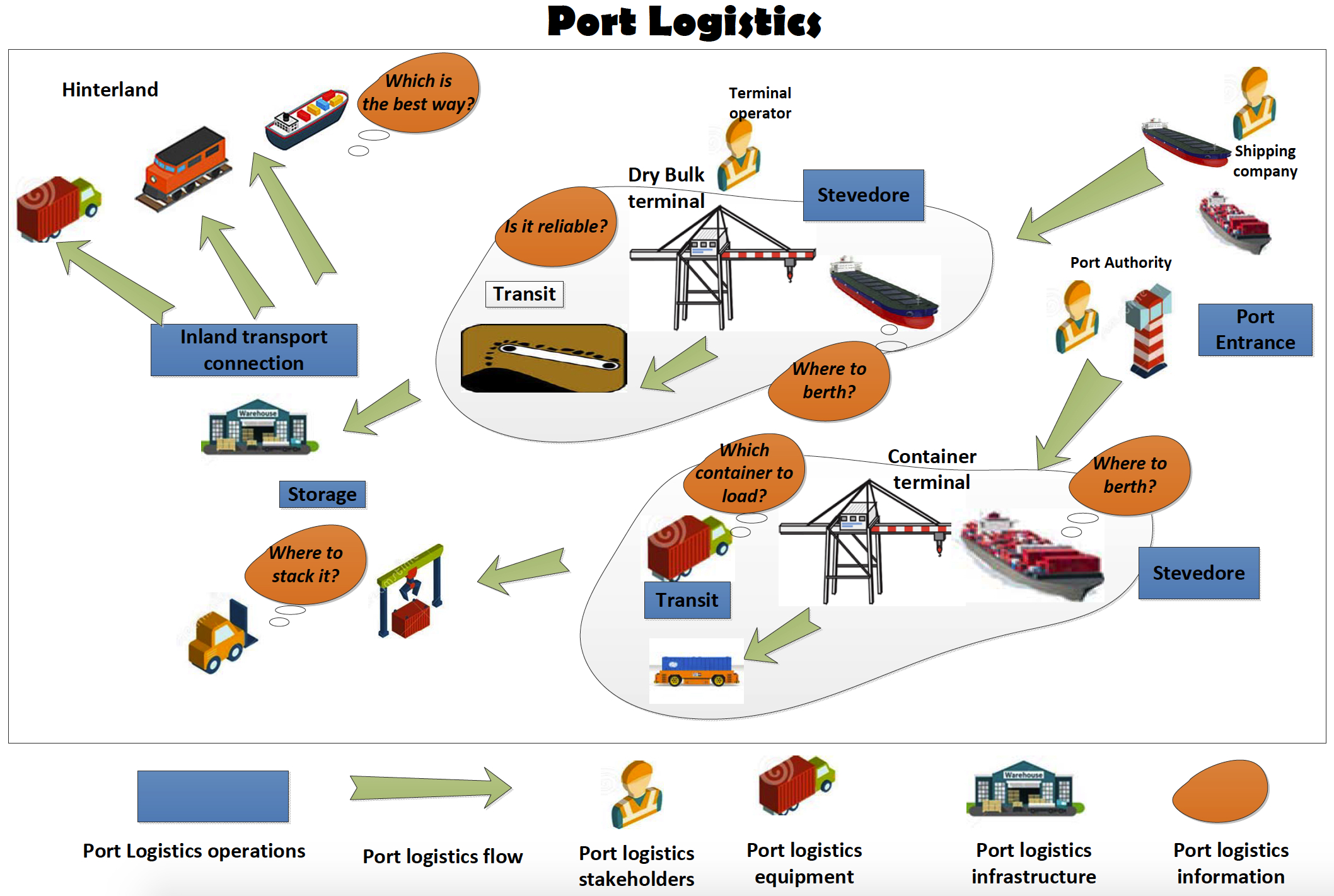Information Integration and Intelligent Control of Port Logistics System
Problem domain
Port logistics (PL) can be defined as the process of planning, implementing and controlling the flow of goods and information between the sea and inland via ports and the other way around. PL systems concern the development of functions to support activities including sea side and land side transportation, cargo storage, order processing, and distribution. Increasing demand and a highly competitive market have forced PL systems to continuously improve their performance, including their operational efficiency and reliability. A key issue is the improvement of decision-making abilities. Decision-making systems play an important role within PL systems, especially as they consider the ways that different processes, operations, and equipment can be controlled and coordinated. With the support of ICT technologies, the decision-making systems have significantly developed. However, several decision making processes lack sufficient ICT support. As a result, the benefits of integrating new ICT supports are unknown, including their benefits for inland vessel coordination and the equipment reliability assessments.
Goals and objectives
The goal of this researcher is to develop an ICT framework to support the decision-making processes and ultimately improve the performance of PL systems.
Approaches
To do so, a hierarchical ICT framework is designed, which consists of two major components: a middleware and an intelligent decision-making approach. With regards of selecting middleware, an agent system is chosen. Likewise, for the selection of intelligent decision-making approach, the meta-heuristics approach is chosen to aid the collaborative planning, whereas context-aware system is chosen for the reliability assessment. To further integrate the selected ICT technologies, a hierarchical framework is designed, which contains three layers: an agent model layer, an agent control layer, and an agent management layer. At the agent model layer, the problems are decomposed and modelled as an agent. At the agent control layer, a coordinate agent is integrated with the intelligent decision-making approach to establish control and coordination. Finally, at the agent management layer, the agent communication facility is established.
Results
The designed framework is first applied to support hinterland barge transport planning at a container terminal. A collaboration and decision-making mechanism is designed for the implementation of autonomous control by means of a multi agent system and meta-heuristics. A bi-level algorithm is also designed and implemented to assist the barge rotation planning. The bi-level algorithm contains a hierarchical structure which combines a genetic algorithm with a simulated annealing algorithm. On top of the the decision making approach, a mediator-based agent framework is implemented to support the communication and coordination between the terminal and the barge party. A simulation study concludes that the implemented system can improve the coordination between the terminal and the barge, as well as improving the quality of rotation plan in terms of the total turn around time and terminal capacity utilisation.
The designed framework is further applied to support reliability assessments of a large-scale belt conveyor system in a dry bulk terminal. A context-aware supervision system is designed to support condition assessment of a belt conveyor system and its maintenance planning. To begin, the belt conveyor system is decomposed into components and operations. Each component and operation is modelled as an agent. Then, a supervision ontology is developed to model the equipment reliability assessment domain. Specific knowledge is incorporated into the ontological knowledge-base. By means of agent-ontology integration, a novel ICT support is delivered. By studying a case of a belt tear condition supervision, the system is implemented and validated to demonstrate that the system can automatically associate all measurements and system information into a linked context. The linked contexts can be further processed using intelligent assessment approach which is embedded into the agent. Eventually a maintenance action can be made and delivered automatically through agent communication and coordination. This improves the current reliability assessment of large scale belt conveyor system by delivering an automated system where different categories of data are mined and linked together to enable integrated decision-making. Furthermore, such a framework can be extended to account for other equipment reliability assessments within a PL system
To conclude, this research investigates the information integration and intelligent control of PL systems by introducing new ICT technologies. The results of this research indicate the potential for applying the designed ICT framework and technologies to improve the performance of the PL system at tactical and operational decision-making levels. Utilising the case studies, the feasibility and the applicability of the integrated ICT framework and the selected ICT technologies are demonstrated.
Funding
This thesis is the result from a project funded by the China Scholarship Council.
Contact person
Dr. YuSong Pang, y.pang@tudelft.nl
Dr Fan Feng, f.feng@tudelft.nl
